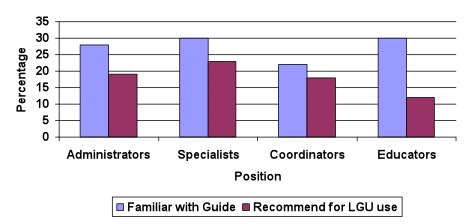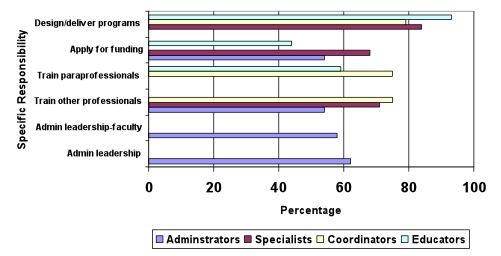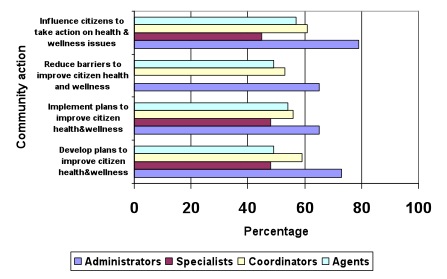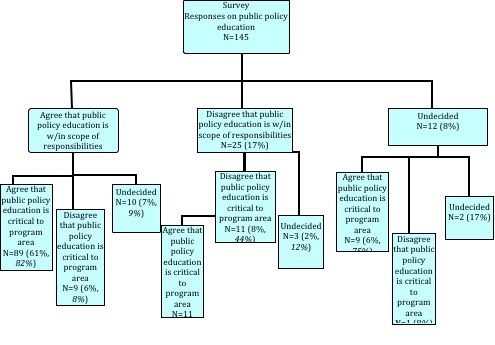 |
October 2009
|
October 2009 // Volume 47 // Number 5 // Feature // v47-5a5
Building Public Issues Education Capacity to Address Health and Wellness: Recommendations from a Survey of Extension Professionals
Abstract
A national Web-based survey administered
through the University of Maryland assessed Cooperative Extension's
involvement in public policy education specific to health and
wellness. Respondents included Family Consumer Sciences
administrators, faculty, and staff. The majority of respondents
agreed that public policy education was within the scope of their
responsibilities, critical to their programs, and helpful in raising
citizens' interest and commitment to healthier communities. However,
public policy education efforts would benefit from a more integrated
approach across the national Extension system in terms of policy
focus and Extension professionals' roles and level of involvement.
Introduction
Public policy education teaches people how to seek and use specific, relevant facts and information to influence and create policies in ways that benefit the public good with enlightened self-interest. It encourages citizens to consider many points of view while finding solutions that are reasonable and balanced (Boyle & Mulcahy, 1993).
Cooperative Extension professionals are tasked with educating the public—individuals, families, and communities—on a number of issues with public policy implications. This education helps citizens engage in public policy development at the local, state, and federal levels. In addition, Extension professionals are often called upon to interpret science for policy makers, to translate policies into practice, or to provide information and technical assistance to help address and resolve problems of importance to their community. Many times policy issues related to food, nutrition, and health are complex and cut across a range of personal beliefs and concerns. Citizens often turn to Extension professionals for help to work through such complex problems, develop or rebuild relationships, and create sustainable solutions (National Public Policy Education Committee, 2002).
However, some Extension professionals are reluctant to engage in public policy. Some individuals lack a conceptual framework for policy engagement. Others are not sure they have administrative support to be involved in public issues education, and they hesitate to act on important issues. Yet, for all the positions in the Extension system—administrators, Extension specialists, educators and agents—there are important roles to be played in public policy education, roles that can be learned (Braun & Williams, 2004). Thus, Extension as an organization needs to be aware of these roles, recognize the importance of Extension professionals' involvement in public policy education (Barrows, 1984), and enhance their capacity to respond to issues important to health and wellness through public issues education (National Public Policy Education Committee, 2002).
One of the strategic recommendations from the National Food and Society Roundtable on Obesity and Youth held in Washington, DC in 2005 was that the Land-Grant University (LGU) system should provide leadership for public policy education that prepares individuals and community leaders to influence policy development at the federal, state, and local levels on issues of obesity prevention and health and wellness. Following this conference, the Public Policy Education Community Action Committee was appointed under the direction of the U.S. Department of Agriculture's Cooperative State Research, Education and Extension Service (CSREES). The committee focused its work on the role of Cooperative Extension in public policy education on health and wellness and determined that insufficient information was available to recommend ways to engage Extension professionals in public policy education strategies.
To obtain additional information, the committee created a survey to assess Extension professionals' understanding of and involvement in public policy education specific to health and wellness among Extension professionals in the range of positions across the system. This article discusses survey findings and suggests a more systematic approach than currently exists to help build capacity among Extension professionals to do health and wellness related public policy education.
Methods and Procedures
For the purpose of the study reported here, a Web-based survey consisting of 17 questions was designed by the committee specifically for Extension professionals. It included questions using a Likert scale of 1 (strongly disagree) to 5 (strongly agree) and a number of other items to help the authors understand the involvement of Extension professionals in public policy education. Questions included years of service, state of employment, and specific public policy questions pertaining to scope of responsibility, critical importance to programs, and impact of actions on change. A specific question was included to assess familiarity with and use of the Sizing Up America Deliberation Guide created to address the issue of obesity (AAFCS, 2006). A comment option allowed for further clarification. Internal consistency of the survey was assessed, with a Spearman-Brown Coefficient of 0.70, yielding moderate internal consistency for the survey's first-time use.
The survey was administered nationally by Internet only (Dillman, 2007) through the University of Maryland to over 500 individuals using targeted list serves maintained by CSREES. Included were Family and Consumer Sciences (FCS) administrators and program leaders; nutrition and health Extension specialists, agents, and educators; Expanded Food and Nutrition Education Program (EFNEP) and Food Stamp Nutrition Education (FSNE) coordinators; and USDA Rural Regional Development Center directors. These groups were included because they conduct efforts in public policy education relevant to health and wellness.
An email cover letter explained the purpose of the Web-based survey and included instructions for completing the survey and the URL for accessing the survey. The survey was open for 2 weeks. A reminder notice was sent once prior to its closure. Instructions included an exemption statement that survey was voluntary and anonymous.
Results
One hundred and forty-five Extension professionals completed the survey. Because some participants did not answer all survey items, the number of responses varied. Cross-tabulation frequency statistics were used to analyze by Extension position, employment region of respondents, years of service, and importance and scope of public policy education in programs.
Response rate defined as the percentage of invitations that resulted in a response was 29%. This is above the response rate of 15% to 25% estimated for e-health-based research (Bowling, Rimer, Lyons, Colin, Frydman, & Ribisl, 2006) and close to the average survey response rate of 33% reported by Michael Braun Hamilton (2003) for online surveys.
While online surveys are inexpensive and easy to administer and provide fast results with real time data across geographic regions, in general they are characterized by many challenges and unanswered questions to include the certainty of reaching those invited to participate. In any given Internet community, there is a tendency of some individuals to respond to an invitation to participate in an online survey, while others ignore it, leading to systematic bias (Wright, 2005). Even though the invitation list used in this survey was targeted, factors that may have influenced the Internet survey non response rate, such as spam blockers, incompatible linkages between major Internet service providers, or browser incompatibilities (Bowling, et al., 2006) go unexplained. To gain a reliable picture of the characteristics of the study survey participants would require conducting multiple online surveys with the same or similar types of targeted online communities (Wright, 2005), a task beyond the scope of this study.
Survey Participants
Of the respondents (n=145), 29% identified themselves as Extension educators; 22% as Extension specialists; 24% as EFNEP/FSNE coordinators; 18% as administrators; 7% as having "Other" appointments in Extension; and 3% did not identify their position.
In terms of Extension work experience, 36% worked more than 20 years; 31% worked 10 to 20 years; 16% worked 5 to 10 years; and 17% worked less than 5 years. The majority of the administrators (46%) and Extension specialists (52%) worked in the system more than 20 years. About one-fourth (24%) of EFNEP/FSNE coordinators reported working less than 5 years, as did 20% of the Extension educators and 13% of the Extension specialists.
Survey respondents (n=139) were mixed as to familiarity with and use of the Sizing Up America Deliberation Guide. This is a National Issues Forums (Fulleylove-Krause, 1991) approach created to address the issue of obesity by engaging citizens in exploring tensions around public issues and discovering common ground for action. Figure 1 shows the percentage of respondents by position familiar with the guide and the percentage of those who recommended using this tool for public education at the LGU. Extension specialists and educators were equally familiar with the guide, but about twice as many Extension specialists recommend its use as did Extension educators (23% vs. 12%).
Figure 1.
Respondents Familiar with
Deliberation Guide and Recommend Use (n=139)
Public Policy Education, Position Responsibilities, and Community Involvement
Specific job responsibilities were reflective of position, but an overlap of both administrative and non-administrative duties was common across all positions (n=135). Figure 2 shows responsibilities for public policy education by position. As expected, administrators reported involvement with administrative duties to include program and faculty leadership and grant management.
Respondents in the other three positions were involved in a number of activities supportive of public policy education, with a common focus on designing and delivering programs at the community, agency, or institutional level. In addition, they were actively involved in the training of other professionals, paraprofessionals or both. A majority of Extension specialists reported applying for or administering grants, scholarships, or fellowships.
Figure 2.
Specific Job Responsibility by
Position (n=135)
Administrators, Extension specialists, and EFNEP/FSNE coordinators reported involvement with state agencies or private organizations, with the majority (n=90) reporting that their primary efforts in public policy education were at the community level. Sixty-three percent of administrators, 57% of the Extension specialists, 76 % of EFNEP/FSNE coordinators, and 70% of Extension educators reported that their work addressed health and wellness public policy issues through community assessment and/or awareness campaigns.
Resultant community actions from Extension involvement by position are shown in Figure 3. Three community actions were common to the four positions: efforts to develop plans to improve citizen health and wellness, the implementation of such plans, and efforts to increase citizen participation or influence them to take action on health and wellness issues. In addition, a majority of EFNEP/FSNE coordinators and Extension educators reported efforts that led to community actions to organize and reduce barriers to improve health and wellness of citizens. Administrators reported a more prevalent role in community planning and in community organization and its implementation than non-administrators, but also led community efforts to reduce barriers to improve health and wellness of its citizens.
Figure 3.
Resultant Community Level Action
by Position (n=90)
In the study, the Extension professionals' involvement in public policy education was related to position and responsibility. The range of professional activities reported here fell into either the content expert or process expert roles (Patton & Blaine, 2001). Content expert roles focus on research and teaching, and process expert roles focus on raising awareness or facilitating the process or discussion to resolve a public issue. While most Extension professionals felt more comfortable with the content expert roles and many activities reported in the study were content based, resultant actions indicated that knowledge about group processes and how to use them were available to the majority of those surveyed in each of the four positions.
Public Policy Education Emphasis, Importance, and Scope
Clearly, Extension is involved with a number of activities that support public policy education with the potential to affect citizen health and wellness. Seventy-nine percent of administrators agreed that an emphasis on public policy education influenced or increased citizens' interest and participation in health and wellness policy action (Figure 3). This effectiveness was somewhat less perceived by the other three, non-administrative positions; also some in those positions were undecided as to whether their efforts actually increased citizens' interest and participation. In this regard, 41% of Extension specialists, 39% of EFNEP/FSNE coordinators, and 27% of Extension educators indicated a need for a consistent process for public policy education and related program evaluation to assess the impact of such education on citizen policy action.
The majority of respondents in each of the four positions agreed that public policy education was critical to their program area and that public policy education fell within the scope of their professional activities (Figure 4). However, 29% of Extension educators disagreed that public policy was critical to their program area, and, overall, 13% of those in non-administrative positions were undecided, suggesting a need for public policy education guidance for these positions. Similarly, 25% of the EFNEP/FSNE coordinators and 20% of the Extension educators disagreed that public policy fell within the scope of their professional activities, most likely due to the emphasis of these positions on program management and delivery rather than public policy education activities.
Figure 4.
Public Policy Education Is
Critical to Program Area: Falls within Scope of Professional
Activities by Position (n=141)
To compare level of agreement on scope of public policy education responsibilities and level of agreement on the critical nature of public policy education to program area, the Chi-Square statistic was used. This analysis produced a matrix of nine groups, ranging from agree on both items to disagree on both items and provides additional insight into respondent characteristics (Figure 5).
Figure 5.
Number of Survey Respondents by
Level of Agreement for Statements on Public Policy Education
Although there was some variance in responses, the majority of respondents (61%, n=89) agreed that public policy education is within the scope of their responsibilities and critical to their program area. They were likely administrators (28%); worked in the LGU system for 10 or more years (67%); worked in the north central or northeast regions (31% and 35%, respectively); and were involved in health and wellness from a public policy approach at the state and community level (56% and 61%, respectively).
Thirteen percent of the respondents agreed that public policy education is within scope of their responsibilities, but either disagreed (6%) or were not sure that this education is critical to their program area (7%). The majority of these respondents worked as Extension educators (47%) and was more likely to be involved in health and wellness from a public policy approach at the community level. On the other hand, 17% of the respondents disagreed that public policy education is within scope of their responsibilities and agreed (8%), disagreed (8%), or were not sure (2%) that this education is critical to their program area. In all cases, respondents worked as EFNEP/FSNE coordinators, Extension specialists or Extension agents/ educators.
Those respondents (n=11) who disagreed with both statements were more likely to be Extension agents/educators (55%) and involved in health and wellness from a public policy approach at the community level (64%). Eight percent of those surveyed were not sure if public policy education is within scope of their responsibilities and agreed (6%), disagreed (1%), or were not sure (1%) that this education is critical to their program area.
Respondents who either agreed or disagreed that education was critical to program areas most often worked as EFNEP/FSNE coordinators or Extension educators (each 33%) and were involved with health and wellness at the community level (89%). Only 1% of those surveyed disagreed with both statements; they differed from other respondents in that they were involved in health and wellness from a public policy approach at the state level.
The relationship between respondent characteristics and responses were explored further using Pearson's Chi Square (Table 1). The chi square determines the probability of discrepancy between the observed and what might be expected (column labeled Asymp. Sig. (2S Sided)). The only differences found were the relationship of job position to active involvement in public policy education at the national level (p = 0.023), with state agencies or private organizations (p =0.00), and at the community level or in other ways (p = 0.034); and for region of work which was related to active involvement in other ways (p = 0.012). The lack of statistical significance for most of the tested relationships in this study likely suggests that Extension public policy education activities are more similar than different across the system.
In the nine subgroupings, the first percentage (%) denotes percentage of total respondents (n=145) who fall in this group. The second percentage (%) denotes percentage of category respondents who fall in this group.
| Respondent Characteristics and Responses | Pearson's Chi Square | df | Asymp. Sig. (2 sided) |
| Job position * public policy education is within scope of responsibilities | 25.222 | 16 | .066 |
| Job position * public policy education is critical to program area | 22.138 | 16 | .139 |
| Job position * actively involved in health & wellness from a public policy approach nationally | 11.327 | 4 | .023 |
| Job position * actively involved within state public agencies or private organizations | 21.539 | 4 | .000 |
| Job position * actively involved within your institution | 1.560 | 4 | .816 |
| Job position * actively involved at community level | 10.438 | 4 | .034 |
| Job position * actively involved in other ways | 21.9 | 4 | .000 |
| Job position * change in involvement | 5.814 | 8 | .668 |
| Years of service * public policy education is within scope of responsibilities | 9.886 | 12 | .626 |
| Years of service * public policy education is critical to program area | 8.065 | 12 | .780 |
| Years of service * actively involved in health & wellness from a public policy approach nationally | 5.125 | 3 | .163 |
| Years of service * actively involved within state public agencies or private organizations | 6.817 | 3 | .078 |
| Years of service * actively involved within your institution | 0.303 | 3 | .959 |
| Years of service * actively involved at community level | 6.467 | 3 | .091 |
| Years of service * actively involved in other ways | 2.030 | 3 | .566 |
| Years of service * change in involvement | 10.388 | 6 | .109 |
| Region of work * public policy education is within scope of responsibilities | 7.555 | 12 | .819 |
| Region of work * public policy education is critical to program area | 9.638 | 12 | .648 |
| Region of work * actively involved in health & wellness from a public policy approach nationally | 1.139 | 3 | .768 |
| Region of work * actively involved within state public agencies or private organizations | 3.591 | 3 | .309 |
| Region of work * actively involved within your institution | 2.402 | 3 | .493 |
| Region of work * actively involved at community level | 3.984 | 3 | .263 |
| Region of work * actively involved in other ways | 10.931 | 3 | .012 |
| Region of work * change in involvement | 4.242 | 6 | .644 |
| * Indicates characteristics and response relationship Indicates statistically significant at p =.05 |
|||
Conclusions
The results of the survey reported here suggest that many Extension professionals engage communities in health policy through public policy education and training of citizens on health issues. While one job position may be more active in the community than another, the lack of statistical significance for most of the tested relationships suggests that these survey participants viewed public policy education and their respective roles with it more similarly than differently. These findings suggest that a focus upon the common elements across position types may be needed for more consistent public policy education with respect to health and wellness.
The results also suggest the need for a more integrated approach across the nationwide Extension system that leverages the integrity and capacity of public policy education under way at local and state levels. For public issues education to be most effective, it needs a focus or context. For example, obesity and its prevention, a compelling nationwide public health concern might become that initial focus, especially given the complexity of this issue at the individual, family and community level and the need for a broader public policy emphasis. In addition, the challenges of obesity prevention are many and would benefit from a concerted effort by Extension (and others) on obesity prevention concepts and policy approaches that encourage population-wide health-promoting behaviors (Dorman, 2007).
The knowledge base needed to address obesity prevention is interdisciplinary and includes not only those programs within family and consumer sciences, but also 4-H youth, agricultural, economic, and/or community development programs. For Extension personnel working in these programs, if obesity is not yet a focus, it could be incorporated in their work. When combined with the necessary leadership found within the LGU system, the issue of obesity and its prevention could increase public policy involvement of Extension professionals. However, along the way, individual differences in skill sets, stages of involvement, and work boundary fears along with lack of leadership, inconsistent guidance, and structural barriers in the system may need to be addressed to help build capacity and strengthen the Extension system.
In summary, many Extension professionals are actively involved in public policy education that affects communities in the areas of health and wellness. However, it is essential for administrators to provide more support for Extension professionals' involvement in public policy education, both general support and support for learning the skills of public issues education. Also, when such education is conducted within the framework of an issue like obesity, it will be possible to clarify the roles and the depth of both current and needed knowledge and understanding of Extension professionals. Doing so will enhance the capacity of Extension to respond and improve the likelihood that our youth and adults will become healthier.
Acknowledgments
Statistical and quantitative analysis provided by Amanda Drescher, Graduate Research Assistant, University of Maryland School of Public Health, Department of Family Science under the direction of Dr. Bonnie Braun.
References
American Association of Family & Consumer Sciences. (2006). Sizing up America deliberation guide. Retrieved October 12, 2009 from: http://www.aafcs.org/policy/deliberationpage.html
Barrows, R. L. (1984). Taking a stand: Extension and public policy issues. Journal of Extension [On-line], 22(2) Article 2FEA1. Available at http://www.joe.org/joe/1984march/a1.php
Bowling, J. M., Rimer, B. K., Lyons, E. J., Golin, C. E., Frydman, G., & Ribisl, K. M. (2006). Methodologic challenges of e-health research. Evaluation and Program Planning, 2: 390-396.
Boyle, P. C., & Mulcahy, S. H. (1993). Public policy education: A path to political support. Journal of Extension [On-line], 31(4) Article 4TP1. Available at: http://www.joe.org/joe/1993winter/tp1.php
Braun, B., & Williams, S. (2004). Democratic engagement: A call for family professionals. In Anderson, C. (Ed.), Family and community policies: Strategies for civic engagement. Washington, D.C.: American Association of Family Consumer Sciences. 1-18
Dillman, D. (2007). Mail and Internet surveys: The tailored design method. New York, NY: John Wiley & Son, Inc.
Fulleylove-Krause, F. (1991). National issues forums: A public policy education tool. Journal of Extension [On-line], 29(4) Article 4TOT2. Available at: http://www.joe.org/joe/1991winter/tt2.php
Dorfman, L., & Wallack, L. (2007). Moving nutrition upstream: the case for reframing obesity. Journal of Nutrition on Education and Behavior, 39(2S):S45-50.
Hamilton, M.B . (2003). Online survey response rates and times background and guidance for industry. Retrieved November 12, 2008 from: http://www.supersurvey.com/papers/supersurvey_white_paper_response_rates.pdf
Patton, D. P., & Blaine, T. W. Public issues education: Exploring extension's role. Journal of Extension [On-line], 39 (4) Article 4FEA2. Available at: http://www.joe.org/joe/2001august/a2.php
National Public Policy Education Committee. (2002).Public issues education: Increasing competencies, enabling communities. Retrieved June 20, 2006 from: http://www.publicissueseducation.net/docs/pie_competencies%2001-15-03.pdf
Wright, K.B. (2005). Researching Internet-based populations: Advantages and disadvantages of online survey research, online questionnaire authoring software packages, and web survey services. Journal of Computer-Mediated Communication. 10(3). Retrieved October 12, 2009 from: http://jcmc.indiana.edu/vol10/issue3/wright.html




